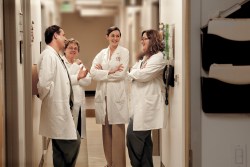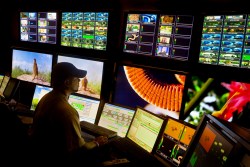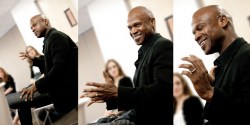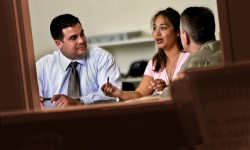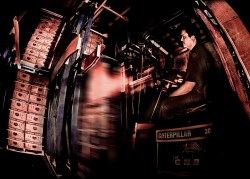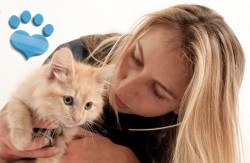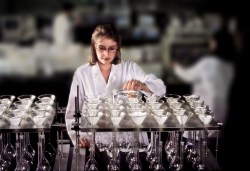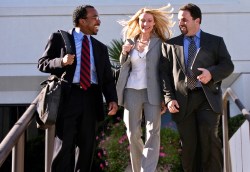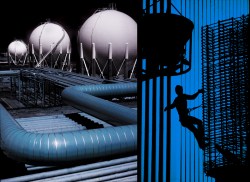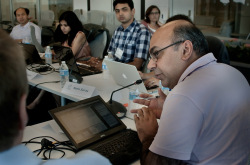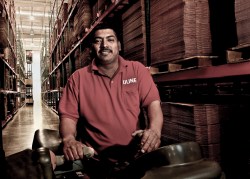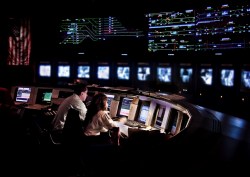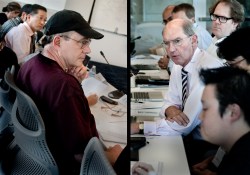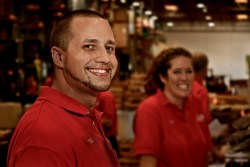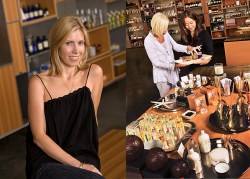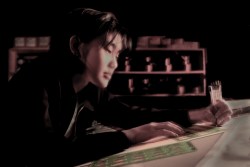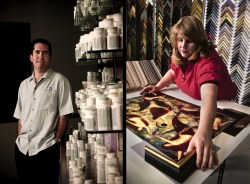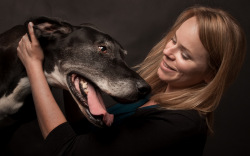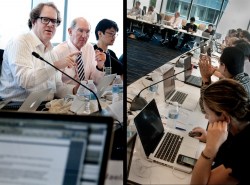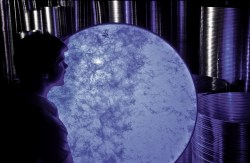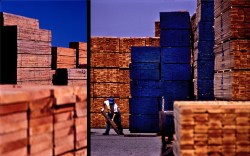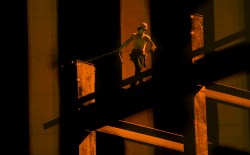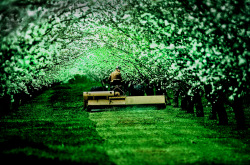Working
rt museum located on Wilshire Boulevard in the Miracle Mile vicinity of Los Angeles. LACMA is on Museum Row, and is adjacent to the George C. Page Museum and La Brea Tar Pits. LACMA is the largest art museum in the western United States. It attracts nearly a million visitors annually.[3] Its holdings of more than 100,000 works span the history of art from ancient times to the present. In addition to art exhibits, the museum features film and concert series.

- Los Angeles County Museum of Art, LACMA
The Los Angeles County Museum of Art was established as a museum in 1961. Prior to this, LACMA was part of the Los Angeles Museum of History, Science and Art, founded in 1910 in Exposition Park near the University of Southern California. Early trustee Howard F. Ahmanson Sr. made the lead donation of $2 million, convincing the museum board that sufficient funds could be raised to establish the new museum. In 1965, the museum moved to a new Wilshire Boulevard complex as an independent, art-focused institution, the largest new museum to be built in the United States after the National Gallery of Art.
The museum was built in a style similar to Lincoln Center and the Los Angeles Music Center and consisted of three buildings: the Ahmanson Building, the Bing Center, and the Lytton Gallery (renamed the Frances and Armand Hammer Building in 1968). The board selected LA architect William Pereira over the directors’ recommendation of Ludwig Mies van der Rohe for the buildings.[4] The LA Music Center and LACMA were concurrent large civic projects which vied for attention and donors in Los Angeles.
Photography
The Wallis Annenberg Photography Department was launched in 1984 with a grant from the Ralph M. Parsons Foundation. It has holdings of more than fifteen thousand works that span the period from the medium’s invention in 1839 to the present, and photography also is integrated into other departments. Although LACMA’s photo collection encompasses the entire field, it has many gaps and is far smaller than that of the J. Paul Getty Museum.
In 1992, Audrey and Sydney Irmas donated their entire photography collection, creating what is now the Los Angeles County Museum of Art’s Audrey and Sydney Irmas Collection of Artists’ Self-Portraits, a large and highly specialized selection spanning 150 years. The couple donated the collection two years before a major exhibition of the collection was mounted at LACMA; the display included photos of and by artistic photographers ranging from chemist Alphonse Poitevin in 1853 to Robert Mapplethorpe in 1988. Among other self-portraits in the collection were those of Andy Warhol, Lee Friedlander, and Edward Steichen.
Audrey Irmas continues to buy for the collection, but now all the additions are gifts to LACMA. In 2008, LACMA announced that the Annenberg Foundation was making a $23 million gift for the acquisition of the Marjorie and Leonard Vernon collection of 19th- and 20th-century photographs. Among the 3,500 master prints are works by Steichen, Edward Weston, Ansel Adams, Eugène Atget, Imogen Cunningham, and Man Ray. The gift also provided an endowment and capital to help build storage facilities for the museum’s photographic holdings, leading to the its photography department being renamed the Wallis Annenberg Department of Photography. In 2011, LACMA and the J. Paul Getty Trust jointly acquired Robert Mapplethorpe’s art and archival material, including more than 2,000 works by the artist.
————————————————————————————–
Los Angeles Public Library Photo Collection
The Central Library houses and archives the extensive Los Angeles Public Library Photo Collection of over 3 million historic photographs from varied sources and collection acquisitions. Many images can be viewed by the public via the online photo collection.The physical Photo Collection an important resource for researchers, writers, curators, and educators
Sources
The Photo Collection’s sources have included: the former Los Angeles Herald-Examiner newspaper photo morgue (2.2 million images); the Security Pacific Bank Collection (250,000); the Los Angeles Chamber of Commerce image archives (60,000), Hollywood Citizen News/Valley Times Newspaper Collection (30,000), and the ‘Turn of the century Los Angeles’ collection (150,000).

- Los Angeles public library – Shades of L.A. photography collection
Collection sources also include the portfolios by noted local and regional photographers, such as: the Ralph Morris Archives (25,000) of the Los Angeles area from 1939 to the late 1970s; a collection of 1940s L.A. images taken and donated by Ansel Adams, and the William Reagh Collection (40,000—800 online) of post-war Los Angeles to 1991.
Shades of L.A.
The “Shades of L.A. Collection” is an archive of more than 10,000 images donated/duplicated from family photo albums (collected by former Photo Collection director Carolyn Kozo Cole) that expanded the archives to include the many diverse ethnic histories of people in the city, beyond the already well represented ‘Anglo’ population.
The project’s success expanded to the California State Library creating the “Shades of California” collection to represent the state’s diverse communities, using the LAPL methods and model. The book “Shades of California: The Hidden Beauty of Ordinary Life” resulted from the successful statewide project. Over a dozen California city and county library districts also created local Shades of California collections, such as Monterey, Riverside, and Humboldt County.
————————————————————————————–
M+B Gallery – 612 North Almond Drive – Los Angeles, CA 90069 – (310) 550-0050 – mbart.com
Price: Free – Hours: Tues to Sat – 10 a.m. to 6 p.m., Sun and Mon – closed
The M+B Gallery displays “Compulsion” by contemporary artist Alex Prager. The exhibit includes a selection of color photographs, several of them interesting close-ups of the eyes, plus the artist’s new short film entitled “La Petite Mort.” The Los Angeles show will be displaying simultaneously with shows in New York and London.
The G2Gallery – 1503 Abbot Kinney Blvd – Venice, CA 90291 – (310) 452–2842 – theg2gallery.com
Price: Free Hours: Sun to Thurs – 11 a.m. to 7 p.m., Fri and Sat – 11 a.m. to 9 p.m.
The G2Gallery will be showcasing the work of Ansel Adams (1902-1984), an American photographer who became famous for his black and white pictures of the American West, often of Yosemite National Park. Aware that a picture can say a thousand words, Adams’ pictures of nature intended to inspire positive changes on behalf of the environment. The next exhibit at The G2Galley will be “Wild on Earth,” the wildlife and cultural photography of Piper Mackay.
Drkrm – 727 S Spring St – Los Angeles, CA 90014 – (323) 271-5635 – drkrm.com
Price: Free Hours: Wed to Sat – 12 p.m. to 6 p.m., Sun – 12 p.m. to 4 p.m., Mon and Tues – closed
The Drkrm will be showcasing Steven Rubin’s “Vacationland”. Rubin is currently an Assistant Professor of Photography at Penn State University, and in the past has worked as a documentary photographer with assignments in the Middle East and in Latin American countries like Chile and Cuba. His work fits right in with what is often displayed at the Drkrm – cutting-edge documentary and photo-journalistic work that displays cultural images of the past and the presen
Annenberg Space for Photography – 2000 Avenue of the Stars, #10 – Los Angeles, CA 90067 – (213) 403-3000 – annenbergspaceforphotography.org
Price: Free Hours: Wed to Fri, Sun – 11 a.m. to 6 p.m., Sat – 11 a.m. to 7:30 p.m., Mon and Tues – closed
The Annenberg Space is showcasing “Digital Darkroom,” the work of 17 artists from around the world who fuse art with technology. Each artist has mastered a particular digital technique such as layered imagery, 3D imaging, picture “stitching” and so forth. Each of the artists has contributed two to six works for a combined display of over 80 prints. Jeff Brouws, Franchised Landscape, Signs Without Signification Portfolio, 2003-2007
Craig Krull Gallery – Bergamot Station – 2525 Michigan Ave, Building B-3 – Santa Monica, CA 90404 – (310) 828-6410 – craigkrullgallery.com
Price: Free Hours: Tues to Fri – 10 a.m. to 5:30 p.m., Sat – 11 a.m. to 5:30 p.m., Sun and Mon – closed
Starting May 26th and and going through July 14th, the Craig Krull Gallery will showcase the work of San Francisco born artist Jeff Brouws. His work is a survey of American rural, urban and suburban landscapes. His pictures turn the mundane and every-day situations into subjects for consideration – from abandoned gas stations to hotels and fast-food restaurants, Brouws makes his viewer give thought to the effects of development and “civilization.”
————————————————————————————–
Los Angeles Photography Studios
Smashbox Studios is a premier photo and film studio in Los Angeles that regularly hosts photo shoots, film shoots, and events for photographers, producers and celebrities.
History
Davis Factor and Dean Factor, great-grandsons of Hollywood cosmetics legend Max Factor, founded Smashbox Studios in 1990.

- Inside the Smashbox Studios Entrance and Lobby
The enterprise expanded to include a photo studio, modeling agency, production company, clothing line, and, in 1996, a cosmetics line called Smashbox Cosmetics. The cosmetic line was sold to Estée Lauder in 2010.
In 2002, IMG and Smashbox Studios began hosting Los Angeles Fashion Week at their Culver City location. 2007 marked its 6th consecutive year.
In 2007 Smashbox Studios merged with Quixote Studios,[3][4] an LA based film and photo studio founded by Mikel Elliot and Jordan Kitaen. Smashbox Studios and Quixote Studios together comprise 15 studios between three locations in West Hollywood, Culver City and Griffith Park. They also have a production supplies and expendable store located in Hollywood and a vehicle lot in West Los Angeles housing a fleet of production trailers, trucks and motorhomes. Each location has grip and lighting departments; espresso bars; and private, celebrity green rooms.
Smashbox Studios has also been featured on various cycles of America’s Next Top Model.
Los Angeles Fashion Week
In 2002, IMG‘s fashion division, which produces Mercedes-Benz Fashion Week in New York, made its first foray west, with Mercedes-Benz Shows LA in downtown Los Angeles at The Standard hotel. Simultaneously, Davis Factor and Dean Factor produced Smashbox Fashion Week Los Angeles at Smashbox Studios in Culver City.

- Smashbox Studios set-up for Los Angeles Fashion Week California
Dozens of designers showed their collections to journalists, celebrities, family and friends at these two centralized venues, while others still chose to show their collections in unique off site venues such as nightclubs, private estates, train stations, churches and lofts. In 2003, IMG and Smashbox united under one banner to streamline services and venues, choosing the Factor-owned Smashbox Studios Culver City location over downtown Los Angeles venues.
In 2009, IMG and Smashbox Studios ended their 5 year relationship on amicable terms and suspended LA Fashion Week.
F.A.C.E. OFF
Smashbox Studios holds an annual photography competition known as the “FACE OFF(Fashion Advertising Celebrity Editorial) for young photographers and photo assistants. In 2007 the 12th annual Face Off show was held at Smashbox Studios Stage 5 in conjunction with Flaunt Magazine and Splashlight Digital.
Gregory is an excellent Los Angeles photographer for corporate, portrait photography.
Corporate Photography By Kirk Tuck / Published by Amherst Media | This excerpt fromCommercial Photography Handbook is provided courtesy of Amherst Media. To purchase the book and learn more about the publisher, visit the Amherst Media website.
Companies hire photographers for more than just advertising shoots. Learn about the kinds of images they need, the skills and tools you need to create them, and how to get and keep corporate clients with this excerpt from Kirk Tuck’s Amherst Media book Commercial Photography Handbook.
This is my favorite category of photography and the field in which I’ve been able to photographers earn the most money, most consistently. In this niche you work directly with large corporations and supply them with all different kinds of images. Though they will usually have a large advertising agency that services their account, the agency will be tasked with creating global or national ad campaigns with large photographers budgets. The agencies will want to hire specific photographers to match the look and feel of the concepts they create. You may or may not be what the ad agencies are looking for. They will be focused on finding a very specific look that is very much “of the moment.”
But those advertising shoots are short lived and, by their very nature, don’t engender much additional work from the same client. And those photographers ad shoots are the tip of the iceberg when it comes to the day-to-day imaging needs of major companies. They will also require a never-ending stream of executive head shots, product documentation shots, press style coverage of major announcements, and lots and lots of event photography.
Top image: Though a style is everything in the realms of photographer fashion and advertising, you never want your style to overpower the content in a CEO portrait. The whole point is to put the attention on the person, not the presentation. For a shot like this, I use a fairly straightforward lighting design that consists of two lights. One is used in a big umbrella or softbox to the subject’s right, and the second is used in a small photographer softbox to illuminate the background. A white board or reflector is used on the opposite side of the subject’s face, providing fill light.
Encouraging Repeat Business
Working for major corporations is so different from advertising photographer photography that it is nothing short of amazing. An ad agency is generally looking for the current “hot photographer.” They want a polished and practiced “one-trick pony” who can overlay his cutting edge style onto their client’s ads. Once the photographer style is mainstream it becomes dated and the photographer is no longer in demand.
In corporate work the opposite is true. If you get your foot in the door at a Los Angeles photographers corporation (generally through the marketing services or public relations departments) and you do a good job at an acceptable rate, you will most likely be invited back again and again. The people inside a corporation are generally looking for good, consistent work that is in a widely accepted style which evolves relatively slowly. They seek repeatable results. They adore “known” resources and reward consistency. In many cases, if you are invited to do a portrait of the CEO (and if the CEO, his staff, and his family like the portrait), you will find the executives all down the hierarchy will demand that their next portrait be taken by the same photographer.
Once you’ve been accepted by one department, and done good work for them, your name will get passed on to the next department. The new department may be charged with getting great photographs of their products. Product photography is a discipline that’s totally different from portraiture, but in the eyes of the corporate guys you are already a proven commodity, and if you say you can do a different kind of task, they will believe you until you prove otherwise. For one high-tech company in my market I provide executive portraits, product photography, complete coverage of all their events (internal and external), and even the artwork on some of their walls.
You get a client like this by building trust assignment after assignment, year after year. And, while corporate rates tend to be smaller than the day and usage rates for advertising photography, you may have gotten a hold of a client that uses you monthly for a decade or longer. All that’s required of you are these three things Los Angeles photographers:
Never promise something you can’t reliably deliver!
Always deliver more than you promise, both in images and in service.
Never forget to thank your client each time they use you.
If your client needs microphotography Los Angeles photographers of products using a specialized light that you’ve never even heard of, you’ll be laying your future assignments with them on the line if you try to wing it. You’d be much smarter to help them find the right specialist. If you’ve built a strong relationship with the Los Angeles photographers client, they will continue to support you. If you try your hand at a technique and fail, especially under a tight deadline, you will have squandered the trust you built and may never recover.
When I say you Los Angeles photographer should always deliver more than you promise I mean that if a client needs a photograph delivered by noon the next day, you should aim to deliver that photograph by 8AM instead. If you see beads of sweat on their foreheads as they make their request for a noon delivery, you would be an even bigger hero if you could deliver the shot by the end of the day. Not all jobs will be a rush, but they will remember that you made their lives easier when it really counted! If you Los Angeles photographer are asked to do a product shot, you should deliver what was asked for but also deliver several variations that they might like even better. If you develop a reputation within the organization as a valued team player, you will be giving yourself a tremendous amount of free word-of-mouth advertising without even trying.
And when I say “never forget to thank your Los Angeles photographer client each time they use you,” I am thinking of several good clients who have stuck with me for so long that they’ve helped me afford a nice house, a good car, and a college fund for my son. Who wouldn’t want to thank business partners like that?
What does it take to be successful as a corporate photographer? You’ll need to know your Los Angeles photographer way around cameras and lights, but you’ll also need to know your way around corporations. You’ll need to know when it’s okay to show up in “business casual” and when it’s critical to show up in something a little more formal. If you work with assistants, you’ll need to ensure that they are equally tuned in to the dress code because they are a direct representation of your business.
I had lunch recently with a friend who is a well known advertising photographer. We met up at our favorite Los Angeles photographer burger joint. Since I was coming from a shoot with a major CEO I was wearing a nice sportcoat and a tie. My friend was dressed in cargo shorts, a tee shirt and a pair of sandals. He laughed at my formal dress. This is Austin, TX, after all; we pretty much invented casual. He mentioned that he had to buy a suit to attend a niece’s wedding. I mentioned that I have seven Los Angeles photographer suits and nearly as many different sportcoats in my closet. That’s one of the requirements of shooting for corporate clients. Ad agencies are only interested in creating an image. Corporations are all about appearances. And it’s always better to be a little overdressed than even one degree underdressed.
What You’ll Need to Deliver
Headshots
You’ll need to provide flattering and consistent headshots. Once you start with a certain custom backdrop you’ll need to use the same basic lighting style and that backdrop for every executive headshot you photograph for that particular corporate client, whether in the studio or on location. The web designers and graphic designers want the consistency because in many cases multiples of executives will be used on the same pages. And nothing is more jarring than warring backgrounds and wildly different Los Angeles photographer lighting styles juxtaposed to one another. You’ll need to be able to deliver retouched files that work well as small Web images, but you’ll need to shoot them at high resolutions in case they decide to make large prints.
Product Photographs
You’ll need to provide product shots that are well lit and are similar to, or better than, the competitors’ Los Angeles photographer images. If your corporate client makes large appliances, you’ll need to learn how to best handle the challenges of lighting large objects, and you’ll need to know how to correct for perspective in Photoshop or in camera. If your client makes microprocessors, you’ll need to get up to speed on shooting things at high magnification, and you’ll need to know how to retouch Los Angeles photographer cosmetic manufacturing flaws that wouldn’t normally be visible to the human eye.
When shooting products of any type you’ll also need to know how to make good clipping paths, which are required for applications where backgrounds are dropped out to white. And you’ll need to make sure that every step of your workflow is calibrated so your results are accurate.
Knowledge of Location Lighting corporate photographer
You’ll need to possess a good working knowledge of location lighting because more and more marketing departments are asking for good environmental portraits in addition to head shots taken against canvas or paper backgrounds. This means being able to “take your show on the road” and still come up with pleasing and corporate photographer consistent results. If you need a little help, you might want to check out my book Minimalist Lighting: Professional Techniques for Photographers. It’s basically a primer on using small lights on location.
Architectural Photography
You’ll be asked, from time to time, to take images of the client’s corporate photographer factories, headquarters, and other buildings, so you’ll want to brush up on your skills in architectural photography as well. This includes interiors and exteriors.
Event Photography
You’ll need to understand how to photograph all the components of weeklong corporate events and be able to provide well-exposed, well-lit, intelligently composed images of everything from the signage at an event venue to available light shots of speakers delivering their presentations, to cocktail parties, to concerts. The event staff will want well-executed shots of the stages (the construction of which may run hundreds of thousands of dollars), the food served, as well as shots of happy corporate photographer attendees lining up to register, networking in the convention spaces, and much more.
Given time and experience you’ll figure out who the “heavy hitters” are, when and how to photograph them, and when (most importantly) to get the heck out of the way and blend into the background.
In my estimation the large showcase events are the most fun and the most challenging part of corporate photography. I love heading to a convention city like Orlando or Las Vegas and spending a week totally immersed in the kind of corporate photographer convention or showcase that shows off the best of my client’s company. We hit the ground running, shoot for twelve to fourteen hours a day, edit down specific events, and constantly feed those images to our client’s PR people and webmasters, and then keep everything archived and sorted. The nice part of shooting a major show is being able to put four or five days of shooting fees and two or three days of editing fees all together in a row. A side corporate photographer benefit is that, as a trusted part of the company’s imaging team, your client will put you up in the same (nice) hotel that their people stay in.
My wife complains that my corporate photographer clients have spoiled me. After having stayed at hotels like the Breakers in West Palm Beach, the Ritz-Carlton in Orlando, the Langham in Pasadena, and a Four Seasons Hotels here and there, it’s tough to get excited about staying in a La Quinta or a Holiday Inn Express for family vacations.
If you make yourself indispensible to a corporate photographer company by dint of your knowledge of their industry, its players, and its social customs, then you’ll find yourself doing a fair amount of enviable travel. Over the past few years, several of my corporate clients have taken me along to wonderful international destinations such as Rome, Paris, Lisbon, Madrid, Monte Carlo, London, and St. Petersburg, as well as really wonderful destinations in the United States and, in each case, I’ve been well compensated corporate photographer for my photographic skills and the travel.
Understanding Corporate Culture
As I’ve said before, the main requirements for corporate photography include the ability to do good, workman-like photography under tight deadlines and in diverse locations. Equally important is understanding the corporate culture of the company you’re working with and fitting into that culture—that means dressing like them, understanding all the human resources issues required by companies, being able to eat with clients in formal settings, and knowing when to shoot and when not to Los Angeles corporate photographers shoot. Some of this you’ll learn over time, but you’ll definitely not be invited back if you:
show up in cutoff shorts and a promotional t-shirt to a formal Los Angeles corporate photographers event
volunteer your unsolicited opinion about any part of the business
draw unnecessary attention to yourself or your photography
evince a prima donna attitude
cause any delays (Most high-end events are timed down to the minute.)
violate any of the rules (A few big stumbling Los Angeles corporate photographers blocks include hitting on the interns, eating a big plate of shrimp at an executive reception, drinking on the job, telling off-color jokes, etc. Everyone in corporate environments has at least one college degree and they expect you to act like a peer.)
fail to deliver the goods.
Equipment
What’s in the corporate photographer’s gear box? It’s all digital now. Any of the major camera systems will work well. I use a pair of Nikon D700s, but by the time you read this they may be old news. I have three main lenses: the 14–24mm, 24–70mm, and 70–200mm f/2.8, but I routinely supplement these with the 60mm and 105mm macro lenses and a few older Los Angeles corporate photographers macro lenses that I use on a bellows close-up attachment. I bring three or four portable flashes that can be controlled by the cameras or by Nikon’s SU-800 flash controller. This is my core event package and the basis of the package I use on most other jobs too.
For head shots, environmental portraits, interior architectural shots, and product shots, I add a range of electronic flashes from Los Angeles corporate photographers Profoto that include: three Profoto Compact Plus monolights, two of the Profoto Acute AB (600B) battery-powered pack-and-head systems, and several of their traditional power packs with four heads. Obviously I pick and choose the components I take to each job. I also have a collection of light stands, umbrellas, softboxes, and reflectors that I use depending on the look and effect I’m trying to get.
In addition to your office computer, you’ll also need a Los Angeles corporate photographers laptop in order to archive and deliver work on location during multi-day events.
This is a category of photography where more is not always better. Many times you’ll need to forego the control and power of a heavier lighting kit to provide more mobility and flexibility. A 13-inch MacBook that fits in the back pocket of my Los Angeles corporate photographers Domke bag trumps my better spec’d 15-inch MacBook Pro. Though clients might appreciate the files from a state of the art, medium format digital back with 60 megapixels, they’ll quickly tell you that they don’t need that kind of resolution and they don’t want to deal with the giant files. Also, you wouldn’t want to carry all of that weight on jobs that may move through five or ten locations in a day.
Breaking In
The best way to enter this part of the field is to assist for someone who does all of the above. Provide the photographer with the same great service you’d give a client, and when the time comes he or she may pass along a potential client whose business creates a conflict of interest for them. Never poach your Los Angeles corporate photographers boss’s clients! It’s in poor taste and it’s tremendously bad karma.
Some Axioms for Doing Business
I’ve been working in this business for a while, and I’ve discovered several axioms. Here they are in list form:All the preconceptions in our industry get rethought decade by decade. When I started out in Austin, TX, it was critical to be able to handle all kinds of work. That “trial by fire” of diversification has been very helpful in successfully competing in the corporate photography sector. It was absolutely the wrong approach if I had wanted to pursue a career as a fashion photographer. If I started over today I’d choose one specialty that included a lot of people to people work, high fees, and relative consistency. In my market it would probably be a combination of high-end, retail portrait photography and wedding photography. In a much larger market I would try my hand at editorial and commissioned portrait work exclusively. At this point I feel so invested with my corporate clients that starting over would be too scary.
The larger the market, the more profitable it is to Los Angeles corporate photographers specialize.
If you specialize, ensure you are casting a wide geographic net. Make the country or the world your market. Look beyond your city and state.
Play to your strengths. If you are a wonderful “people person” and you are delighted to make new friends, you probably won’t be a happy product or still life photographer, but you might be a wonderful wedding guy. Let your strengths lead you to your specialty!
People like to buy expertise, so make sure your marketing reflects this. If you want to be a wedding photographer and an advertising or corporate photographer, then consider investing in two different company identities with two different websites.
When starting out, try to immerse yourself in as many of the niches as possible to facilitate the “aha!” moment when everything becomes clear and you discover your preferred specialty.
If you are working in a smaller market, be sure to master several related specialties. You’ll want some diversification in your primary market. Just don’t try to market too many “personalities” to the same decision makers.
Time in the market can build your reputation and your clients’ ability to remember your name, so be consistent and market yourself with a view to the long term.
Charge for what you know, not what you do Los Angeles corporate photographers . If you are the best at a particular specialty, be sure you charge accordingly. That means charging more for the things you do well, not charging by the hour for something you can do quicker and better as time goes on!
If you are aiming for the biggest Los Angeles corporate photographers markets it pays to perfect your work in your current market and “arrive” as an expert rather than as a journeyman.
Do what makes you happy, not what seems like the coolest part of the business. If you are truly having fun, it will be easier to make money because your enthusiasm will be contagious.Think about this as you contemplate where you want to be in five, ten, and twenty years. Make sure that the “fun quotient” has the potential to stay high in Los Angeles corporate photographer.

